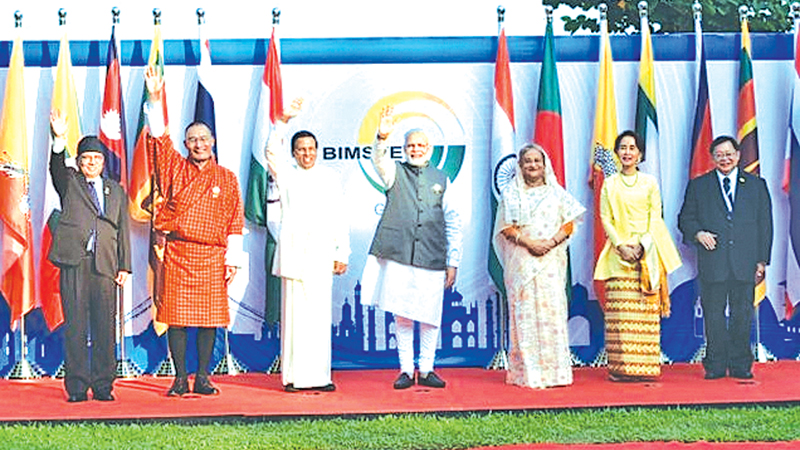The recent visits by Bangladesh PM, Nepalese President, and upcoming trip of Sri Lankan PM to India this week has given momentum of BIMSTEC Motor Vehicle Agreement (MVA), envisaged as a multil-modal regional connectivity initiative between seven states of BIMSTEC after the proposed SAARC MVA could not be concluded due to Pakistan’s intransigence.
 The BIMSTEC MVA, that will be key outcome of the group’s fourth Summit in 2017 to celebrate 20 years of creation of BIMSTEC, will have all multi-modal features connecting Sri Lanka which is connected to rest of six members of grouping only through air or sea, persons familiar with the issue told ET. As part of this goal, the grouping also hopes to put in place BIMSTEC Framework Agreement on Transit, Trans-shipment, and Movement of Vehicular Traffic.
The BIMSTEC MVA, that will be key outcome of the group’s fourth Summit in 2017 to celebrate 20 years of creation of BIMSTEC, will have all multi-modal features connecting Sri Lanka which is connected to rest of six members of grouping only through air or sea, persons familiar with the issue told ET. As part of this goal, the grouping also hopes to put in place BIMSTEC Framework Agreement on Transit, Trans-shipment, and Movement of Vehicular Traffic.
Intra-regional connectivity and BIMSTEC process was a key element in the agenda of visits by leaders of member states—Bangladesh, Nepal, and Sri Lanka to India—in quick successions.
 Eyeing better integration among the seven member states, BIMSTEC is also taking into consideration other national, bilateral, and regional efforts that are on-going in region, officials pointed out. This includes, among others, the BIG B (Bay of Bengal Industrial Growth Belt), which is a bilateral effort between Japan and Bangladesh, influencing the connectivity scenario in the region and is very much relevant to BIMSTEC. Besides BBIN MVA, a sub-regional initiative comprising four of seven BIMSTEC states is expected to complement BIMSTEC’s efforts amid SAARC’s inability to make headway due to Pakistan’s intransigence on several issues including counter-terror mechanisms and connectivity initiatives, experts on the subject explained. BIMSTEC hopes to create a common security space—which SAARC failed to achieve in the past three decades—to deal with common security challenges.
Eyeing better integration among the seven member states, BIMSTEC is also taking into consideration other national, bilateral, and regional efforts that are on-going in region, officials pointed out. This includes, among others, the BIG B (Bay of Bengal Industrial Growth Belt), which is a bilateral effort between Japan and Bangladesh, influencing the connectivity scenario in the region and is very much relevant to BIMSTEC. Besides BBIN MVA, a sub-regional initiative comprising four of seven BIMSTEC states is expected to complement BIMSTEC’s efforts amid SAARC’s inability to make headway due to Pakistan’s intransigence on several issues including counter-terror mechanisms and connectivity initiatives, experts on the subject explained. BIMSTEC hopes to create a common security space—which SAARC failed to achieve in the past three decades—to deal with common security challenges.
Further, a recent study conducted by Jaipur-headquarter think tank CUTS International and BIMSTEC Secretariat based in Dhaka suggested that tourism corridors can be effective precursors to business corridors since regional tourism can help attract investment vis-à-vis building confidence among the political constituencies in the region.
“Borders in the region need to be thinner than they are at present. Each country in the BIMSTEC region needs to work on small enablers at the borers, like better four lane roads, parking, testing, currency exchange, immigration, and other facilities at the borders which can be tackled at the domestic level before taking on regional challenges,” the study further recommded.
One of the other important aspects is to look at waterways as part of the multi-modal connectivity network to enable sea access by land-locked countries and regions like Bhutan, Nepal, and the North Eastern states of India.
“Maritime connectivity is extremely important for the BIMSTEC region, given its geography and also geo-strategic importance. Strengthening and enhancing cooperation on maritime and coastal shipping will be critical towards securing both, economic and security dividends. The key to connectivity within BIMSTEC lies in its history, and the member countries need to realign their historical alliance, reinvigorate historical nodes and hubs, and remove barriers that frustrate trade, investment, and people-to-people exchange,” the study recommended.



Add new comment